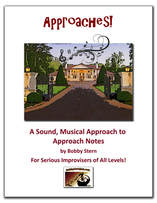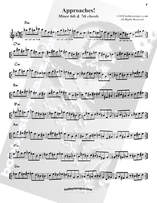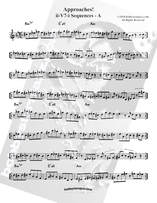A Sound, Musical Approach to Approach Notes

Approach notes can be a single note or single and double note combinations of chromatic and/ or scale tones which approach the target note from below and/ or above. They are sometimes referred to as "enclosures", since they tend to surround or enclose the intended target note.
Employing the use of approach notes is an important and time tested technique for creating tension and release within an improvised melodic line, through delayed resolution as well as basic ornamentation.
Ex. 1
In the example below, an ascending and descending C Melodic Minor scale is depicted with chromatic approaches from above & below (+ch / -ch, in my own shorthand), with the diatonic target notes (scale tones) falling on beats 2 and 4. This type of chromatic approach from above and below fits the description of an aforementioned enclosure, where the target note is surrounded from above and below (Db - B to target C, and Eb - C# to target D in measure #1).
Measure #2 is interesting in that it starts with a non-scale tone and Maj 3rd, E, to D to target Eb. On first hearing, this might sound dissonant or just plain wrong - E being the Maj. 3rd against a minor scale. F, a diatonic scale tone to C min, might sound more... diatonic, so it's your call.
However, the idea here is to keep a constant structure - chromatic above to chromatic below (an interval of a Maj. 2nd) to the Melodic Minor scale tone target, which means that E and not F is indeed the note of choice in this case.
Below is an example of a 3-note approach (for the most part) on an ascending C Major scale, starting on beat 1 with a scale tone (C, the root). It then approaches the target note, the next diatonic scale tone (D) on beat 3 via two semitones (double chromatic) from above (E & D#), to chromatic from below (C#).
The pattern is interrupted on the "and" of beat 3, as the logical approach would be F# - F - D#, whereby the F# creates a slight a dissonance. I decided, for the sake of variety, to omit the F#, move the F from beat 4 to the "and" of beat 3 and replace it with an eighth note rest.
Breaking up the constant flow of eighth notes momentarily without upsetting the basic integrity of the sequence itself, creates momentary tension and release. Silence tends to do that.
The same thing happens again in measure #3, where C is moved from beat 4 to 3 "and". The logical approach note C#, is omitted and replaced with an eighth note rest on beat 4. Works for me!
This next example of a 4-note approach targets a descending Dmin6 or 7th chord arpeggio and its inversions. The interval make-up of this approach in the first 3 measures is again a "constant structure" (Maj 3rd - up/ min 3rd - down/ Maj 2nd - up), resolving, in each case, downward chromatically to a Dmin7 chord tone target.
Since the type of minor scale in question here is not specified, both Bb on beat 1 (Natural and Harmonic Minor) and B natural on beat 2 (Dorian mode and Melodic Minor) of measure #1, are designated as scale tones, approaching from below (-st). The target note here is C, the 7th of Dmin7, on beat 3.
After the top three notes of Dmin7 (C, A & F) are spelled out in the second half of measure #1, the 4-note "constant structure" approach continues in measure #2; but not before being smoothly approached itself, chromatically from below, by a conveniently placed F# on the "and" of 4.
Each measure has a pronounced V7-i harmonic feel to it, due mainly to the presence in each measure of at least two notes from the same Diminished 7th chord (C#-E-G-Bb), which make up an A7b9 or Eb7b9 (V7 or bII7 in D).
This leads us into a pair of minor ii-V7-i examples, using similar approach techniques as those in the previous examples.
Approaching chord tone F on beat 3 of measure #1, is a 4-note approach grouping E-G-Gb-E or chromatic from below / to double chromatic from above / to chromatic from below (-ch / +2chr / -ch).
From the target note F, we walk up diatonically in F Melodic Minor (F-G-Ab-Bb) on beats 3 and 4, only to land on beat 1 in measure #2 on a... Gb? The chord symbol says G7 so shouldn't the note be a G? Hmmm.....
There are at least 2 ways to look at this...
The first is that the target note in this case is obviously something other than G, since approach resolutions are normally by a half or while step. This points to the target actually being Ab on beat 3 of measure #2. Ab is the b9 of G7 and also the root of the Ab Melodic Minor scale, from which a complete G7 altered chord is derived. To wit, the Ab min. triad on beats 3 and 4.
In either case, the 4-note approach to target note Ab is: whole tone from below / to double chromatic from above / to chromatic from below (-wt/ +2ch/ -ch).
The use of an eighth note rest on the "and" of beat 1, and the eighth note triplet on beat 2 add rhythmic variety while keeping the shape of the grouping, similar that of the first half of measure #1, intact.
The final Ab on the "and" of 4 resolves by +ch to G (C min.) on the first beat of measure #3.
Both 4-note approaches in measure #3 are of the same make-up as the first half of measure #2 (-wt/ +2ch/ -ch), targeting A on beat 3 (another approach grouping) and B on beat 1 of measure #4.
In the audio example, these approaches are harmonized with alternate changes.
An interesting characteristic of the minor ii-V7-i below is that targeting non-chordal scale tones of Melodic Minor - which has no avoid notes - can sound pretty hip. Such is the case with the targeted Bb on beat 3, measure #1 (+ct / -2ch), approaching it from the eighth-note triplet on beat 2.
Following the Bb with a 3 note approach (Ab - F & F#), the expected target note would most likely be G on the first beat of measure #2 (as in Ex. 4). Quite sneakily however, the note is instead Ab (b9 of G7). It becomes part of an enclosure (+ch/ -ch), which includes F#, and in turn targets G in delayed fashion, on beat 2.
Approached chromatically from above (Gb), the line moves forward via an arpeggiated G7+5 (F-G-Eb-B) on beats 3 and 4 of measure #2.
The fun then continues in measures 3 and 4 with a variety of diatonic and chromatic approaches, creating a snakey, ascending C minor line.
Dmi7b5 G7alt C min
A helpful primer for the material here is an earlier Shortbook™,“Chromatix”, which focuses on the
smaller intervals of half and whole steps, from which the bulk of diatonic and chromatic approaches
are formed.
Be patient and don't be afraid to experiment. Invent your own approach sequences over a given set
of chord changes.
In the noble words of a most highly respected Duke, “If it sounds good and feels good... it is good!”
B.Stern










 RSS Feed
RSS Feed









